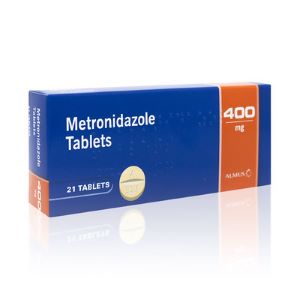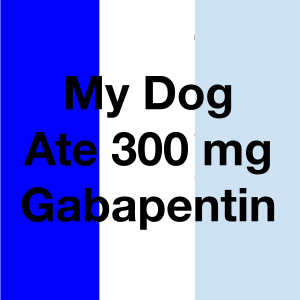
When your dog has a bout of diarrhea it is a distressing event for the poor animal that is often kept awake at night by frequent bathroom trips, as well as for you, who have to be on call for those bathroom trips and clean up after an accident.
Fortunately, there’s metronidazole to fix the problem, or at least that’s what the vet told you.
Sadly, after a course of antibiotics many pet parents discover the diarrhea has returned and the dog is as miserable as ever.
What’s to be done?
First of all we need to have a better look at this drug and see whether it is indeed useful for all types of diarrhea.
It is, after all, an antibiotic and these types of drugs are known to cause diarrhea. In this article we’ll have a look at what metronidazole, its side effects, as well as other diarrhea remedies you might want to use to cure your ailing pet.
What is Metronidazole?
Metronidazole has been around since the 1950s and is widely used to treat a large number of infections in both humans and pets.
Metronidazole is first of all an antibiotic that targets anaerobic bacteria, or bacteria that don’t need oxygen to survive.
At the same time, metronidazole has been used as an antiprotozoal, to kill parasites such as Giardia.
When the vet puts your dog on metronidazole, you’ll probably be very impressed how fast it works.
Many pet parents reported their dog’s stools were back to normal, solid and well-formed, within 24 hours.
The problems start the moment you take the dog off the drug and the dog is back to having watery stools.
One possible explanation is that vets tend to overprescribe this type of medicine, using it to treat all types of diarrhea, not only those caused by specific bacteria that metronidazole targets.
As such, metronidazole only alleviates the symptoms, without treating the underlying cause of the dog’s problem, which is why diarrhea returns once you take him off the antibiotic.
What is metronidazole used for?
If you’re reading this article, your pet obviously has diarrhea.
The most common cause of diarrhea in both humans and animals is the bacteria Clostridium difficile.
Metronidazole is considered very effective against bacteria in the Clostridioides family. It acts by going in and killing the bacteria rather than slowing its growth.
This antibiotic is also used to treat gastritis caused by the Helicobacter bacteria. It can be prescribed to treat bile duct and gallbladder infections.
Metronidazole can even penetrate bone structures, which is why it is often used to treat tooth and jaw infections.
How long does metronidazole take to work in dogs?
According to experts, you should see some improvement in as little as 1-2 hours.
Not that the dog would be perfectly fine in such a short time, but the frequency of those dreadfully annoying bathroom trips should be reduced.
Little by little, the consistency of the dog’s stools should improve. All in all, it will be at least a couple of days until the dog starts feeling OK.
In most cases, vets put dogs on a 5-10 days course of antibiotics to treat diarrhea. If the situation is really severe, the vet might prescribe 14 days of metronidazole.
How is metronidazole administered to dogs?
Metronidazole comes in various forms, such as pills and liquid suspensions.
For diarrhea, doctors usually recommend a dosage of 5-7 mg per pound every 12 hours.
If your dog has giardia, the dosage might be increased to 7-11 mg per pound of body weight, but given only once a day.
These are just general recommendations.
You should always follow the doctor’s orders as they take into account other things such as the dog’s age and general health condition.
In most cases, you’ll be told to give the dog metronidazole in pill form and this is going to be very tricky as this drug is very bitter.
Avoid crushing the pills as this will only make it more difficult to convince the dog to take his medicine.
The best thing is to hide the pill in a treat you know your dog is unable to resist.
Why does my dog still have diarrhea after a course of metronidazole?
Metronidazole is very effective against various types of bacteria and this might be the cause of your pet’s continuing problems.
The antibiotic is too effective and kills the good bacteria as well. In its fight against bacterias like C.Difficile, metronidazole wipes out the good bacteria in the dog’s guts, such as Fusobacteria, which helps with digestion.
According to one study, a 14-day course of metronidazole vastly reduces the types of bacteria making up a dog’s microbiome, or the totality of microorganisms living happily inside his intestines.
The study found that certain bacteria had been virtually eliminated by the antibiotic, while those still present were there in very small numbers.
The dog’s microbiome will need time to get back to normal.
The study revealed that even after four weeks, the dog’s microbiome was still horribly unbalanced.
At this point you cannot expect his digestion to be back on track.
One way of mitigating the devastating effects on the animal’s microbiome is to give the dog probiotics for the duration of the metronidazole treatment.
After all, this is the reason why people take probiotics when they’re put on antibiotics and it can also help dogs preserve the good bacteria in their guts.
Is metronidazole effective against giardia?
As mentioned above, metronidazole is also an antiprotozoal and has been used for decades to treat dogs infested with the giardia parasite.
The microscopic parasite Giardia duodenalis is usually transmitted when the dog drinks contaminated water.
When this unicellular parasite latches on to the intestinal walls it causes an acute episode of a foul-smelling diarrhea often tinged with blood.
Recent studies show that this tiny parasite has developed resistance to metronidazole.
If your vet recommends this antibiotic alone it might not be enough to eliminate the parasite completely.
As a result, after a week or so of metronidazole the parasite will still be there and, in the meantime, the dog’s intestinal biome has been destroyed.
No wonder the dog still has watery stools and is feeling miserable once he’s off the meds.
At present, experts suggest a combination of metronidazole and fenbendazole might be more effective in treating giardia.
What are the side effects of metronidazole?
Like all medicines, metronidazole can cause some very unpleasant side effects. Here are the most common side effects of this antibiotic:
- Loss of muscle control
- Loss of coordination
- Tremors
- Seizures
- Vomiting
Experts also recommend avoiding giving metronidazole to a pregnant or nursing dog.
Many puppies experience episodes of diarrhea when moving to their new homes and the assumption is that they might have a parasite.
Unfortunately, worried pet parents rush to the vet and they almost always get a prescription for metronidazole.
This is often a recipe for disaster as the puppy will have a hard time restoring the balance of the intestinal microbiome, and will end up being put on antibiotics yet again.
Doctors also advise caution if the dog is known to have liver problems as the drug might only make those worse.
What are the alternatives to metronidazole?
Doctors constantly caution against the overuse of antibiotics, and this might be the case with dogs as well.
The problem is simple.
When you take your dog to the vet, they will immediately prescribe metronidazole as experience shows it stops diarrhea and what happens next week is less important.
The ideal solution would be to have the vet run a full set of tests on your dog to make sure the diarrhea is indeed caused by a bacteria.
This should include a fecal matter test. Running all these tests takes time and costs more money pet owners can sometimes afford, so it’s much easier to prescribe a drug and see what happens.
Another problem is that giardia is notoriously difficult to diagnose and the doctor might simply assume it’s there.
If your dog is not in a really bad state, you should consider changing the dog’s diet and see if it helps.
Most cases of diarrhea are, in fact, of an unknown origin and putting him on a bland diet for a few days can solve the problem.
A bland diet consists of boiled rice and chicken breast, obviously unsalted.
Give the dog small meals at regular intervals rather than one large meal. If the dog is not happy with it, just wait until he becomes truly hungry and he will probably change his mind.
Also, you can add some plain pureed pumpkin, which calms the bowel inflammation and also adds bulk to the stools.
Since diarrhea is often associated with an unbalanced microbiome, you should try to address that as well.
You can use prebiotic fibers, such as inulin and psyllium (brand name Metamucil), which help balance the intestinal flora and improve the quality of the dog’s stools.
Another dietary supplement you can try is S. boulardii, which supports the growth of good bacteria.
Closing thoughts
Metronidazole is one of the most common treatments for diarrhea in dogs.
However, if the problem is not caused by a bacteria such as Clostridium difficile, the antibiotic might make things worse without solving the problem.
If the dog has diarrhea of unknown origins it’s best to try a more conservative approach, such as a bland diet and some prebiotics to correct any imbalance in his intestinal microbiome.
In those cases when the vet decides metronidazole is indeed necessary make sure the dog also gets probiotics to help preserve the good bacteria, so he won’t have diarrhea again once he finishes a course of antibiotics.






